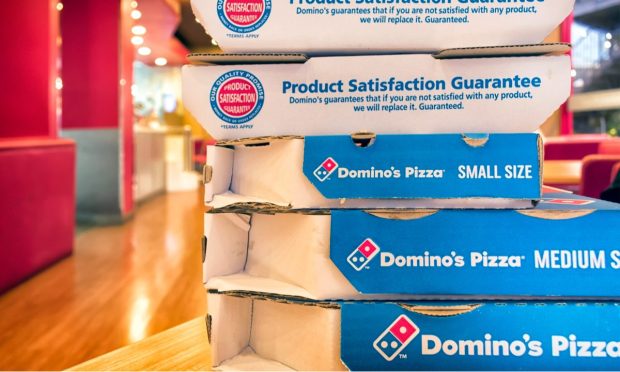Domino’s Uses Pricing to Drive Carryout Purchases in Advance of CEO Changeover

As the restaurant industry’s labor, pricing and supply chain challenges persist, brands are finding it increasingly difficult to run a profitable delivery business. As such, Domino’s Pizza, historically a very delivery-reliant company, is doing everything in its power to incentivize adoption of its pickup channels.
“We continue to see very strong growth in carryout segments, while it really is that delivery business that has been more constrained by driver labor,” Domino’s Chief Operating Officer and President Russell Weiner, shared on a call with analysts Tuesday (March 1) discussing the company’s fourth-quarter and full-year 2021 earnings results.
Domino’s also announced Tuesday that Weiner would be taking over as CEO May 1 after the company’s current CEO, Ritch Allison, retires.
This push to shift ordering from delivery to takeout in part takes the form of advertising and marketing messaging as well as limited-time promotions. For instance, at the end of January, the company announced an initiative promising to “tip” consumers when they order carryout as consumers tip delivery drivers, offering a $3 credit for their next carryout order, which had the added advantage for Domino’s of incentivizing repeated purchases.
Read more: Domino’s ‘Tips’ Customers for Pickup Amid Push to Shift Delivery Labor to Consumers
Additionally, the company is focusing its pricing actions more on delivery than on pickup, dissuading consumers from using the more costly channel.
“The carryout business opportunity is two times that business in pizza than delivery, and so we want to be aggressive there,” Weiner said. “Moving delivery to $6.99 … is that surgical approach and allows us to keep the carryout offer where we need to do competitively.”
Research from PYMNTS’ Restaurant Friction Index, created collaboration with Paytronix, which drew from a survey of more than 500 managers of full-service restaurants (FSRs) and quick-service restaurants (QSRs) across the United States, found that 77% of restaurants offer the ability to order online and 67% offer curbside pickup. Additionally, the study found that, as of September, 41% of restaurants’ sales were coming through digital channels.
See more: New Data Show Digital Loyalty Programs Are Key Differentiator for Top-Performing Restaurants
Plus, the Index’s survey of a census-balanced panel of more than 2,100 U.S. consumers found that 40% of customers would be more inclined to purchase from restaurants that offer the ability to order and/or pay online, a third of customers said the same of curbside pickup.
In January, Allison announced in a presentation at the 2022 ICR Conference that the company was making changes to its $7.99 carryout chicken wing deal, making the offer exclusively available through digital channels and reducing the number of wings per order from 10 to eight.
Read more: Brands Turn to off-Premise Formats to Boost Profit Margins
“When you bring that to online, we know our online carryout ticket is 25% higher than phone, so there was intention to that,” Weiner said on Tuesday’s call. “We get customers’ names, [and it] works with our loyalty program.”
By getting consumers’ information, brands are better able to communicate with their customers, which in turn softens the impact of difficult conditions on the brand’s sales.
“Digital engagement mechanisms to keep close to the guests are paramount,” Paytronix CEO Andrew Robbins told PYMNTS’ Karen Webster in a January interview. “So, a strong loyalty CRM program, online ordering, those are the twin pillars of a good strategy. And we see this every single time there’s a downturn.”
See more: Restaurants Lean on Loyal Customers to Navigate Omicron, Inflation Impact
